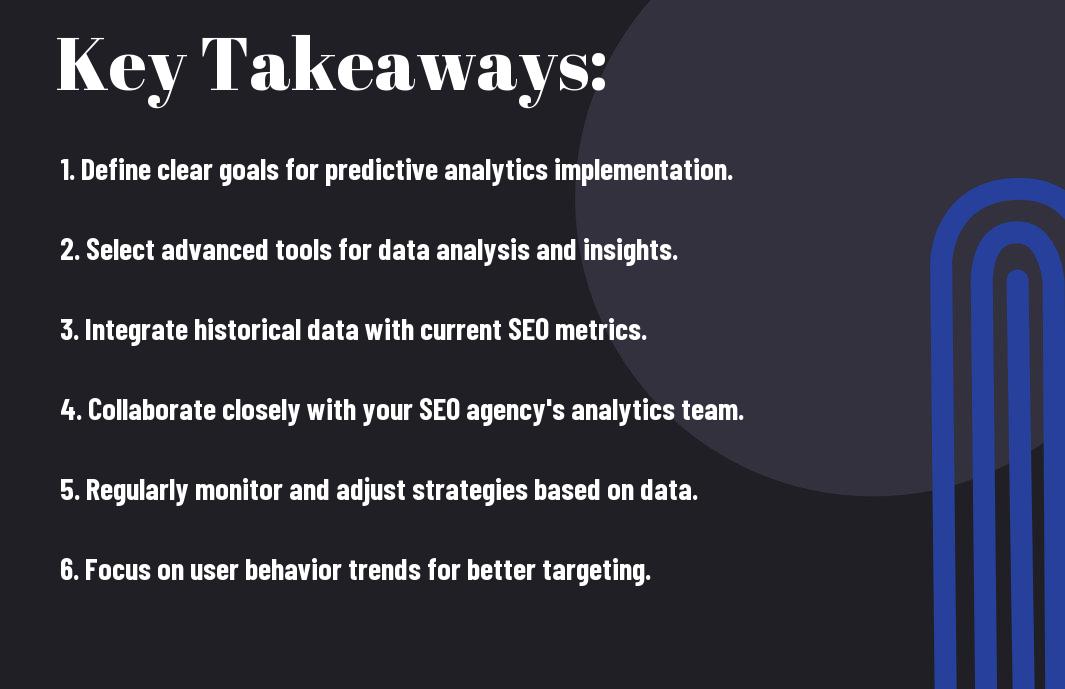There’s a vital need for businesses to harness the power of data, particularly when it comes to SEO strategies. By ensuring that their SEO agency incorporates predictive analytics, they can proactively respond to market trends and customer behaviors. He or she must prioritize communication with the agency to facilitate a strong data-driven approach, while also working to establish clear key performance indicators. By recognizing the importance of these steps, they can significantly enhance their SEO efforts and secure a competitive edge.
Key Takeaways:
- Identify relevant KPIs and metrics: Clearly define the key performance indicators that align with your business goals to measure the effectiveness of your SEO efforts.
- Incorporate data-driven decision-making: Ensure that your SEO agency utilizes historical data and trends to predict future performance and make informed strategies.
- Leverage advanced tools: Encourage the use of predictive analytics tools that can analyze large data sets for actionable insights and optimization opportunities.
- Foster a collaborative approach: Maintain open communication with your SEO agency to discuss analytics findings and adjust strategies accordingly for continuous improvement.
- Monitor and evaluate predictions: Regularly assess the accuracy of predictive models and refine them based on new data and market changes for sustained success.

Understanding Predictive Analytics in SEO
Before venturing into how predictive analytics can enhance an SEO strategy, it is important to grasp what predictive analytics entails.
Definition of Predictive Analytics
Predictive analytics is a form of advanced analytics that involves the use of statistical algorithms, machine learning techniques, and data mining to analyze historical data. By doing so, it aims to predict future outcomes and trends, providing actionable insights for decision-making. In the context of SEO, predictive analytics helps agencies anticipate changes in search engine algorithms, user behavior, and market dynamics.
Through the application of predictive models, SEO professionals can identify key performance indicators (KPIs) that may significantly impact their strategies. They can assess which keywords are likely to gain traction, how traffic patterns might shift, and what elements could enhance user engagement. This capability allows SEO agencies to adapt proactively rather than reactively, positioning their clients for long-term success.
Importance of Predictive Analytics in SEO
Against the backdrop of constantly evolving digital marketing landscapes, the importance of predictive analytics in SEO cannot be overstated. It enables agencies to gain insights into future trends and engage in data-driven decision-making, ultimately enhancing their clients’ online presence. By leveraging predictive analytics, they can allocate resources more effectively and prioritize strategies that yield significant returns on investment.
Moreover, predictive analytics offers agencies the ability to enhance their understanding of audience behavior. By analyzing past user interactions, they can anticipate future content preferences and tailor their approach accordingly. This level of foresight can be a game changer in a competitive market, driving higher engagement and conversion rates.
Key Components of Predictive Analytics
Above all, the successful implementation of predictive analytics in SEO relies on several key components. They include data collection, data processing, model building, and performance evaluation. Data collection involves gathering historical data from various sources like website analytics, social media insights, and market research. This data must then be processed to ensure accuracy and relevance.
Model building is the phase where algorithms and statistical techniques are applied to predict future trends based on the processed data. Finally, performance evaluation allows SEO professionals to assess the accuracy of their predictions and make necessary adjustments to improve their strategies. This structured approach enables agencies to generate meaningful insights that can inform their decisions.
More on Key Components of Predictive Analytics
But, it’s important to note that successful predictive analytics also hinges on the quality of the data being gathered. Without robust data, predictions can become unreliable and lead to misguided strategies. Ensuring that the collected data is accurate, timely, and comprehensive will empower SEO agencies to make informed decisions that drive results.

Selecting the Right SEO Agency
The success of any digital marketing strategy depends significantly on the choice of the SEO agency. He or she must ensure that the selected agency aligns closely with their unique needs and goals, particularly when it comes to utilizing predictive analytics. Predictive analytics involves leveraging historical data and trends to forecast future outcomes, which is important for crafting effective SEO strategies. Thus, thorough evaluation of potential agencies is necessary before making a commitment.
Evaluating Agency Experience with Predictive Analytics
One important aspect to consider is how well the agency integrates predictive analytics into their strategies. He or she should look for an agency that has demonstrated a solid understanding of *predictive modeling*, *keyword forecasting*, and *trending analyses*. An agency’s track record with predictive analytics will likely reveal its capability to anticipate changes in search engine algorithms, user behavior, and market trends, ensuring that their strategies remain proactive rather than reactive.
Additionally, evaluating the agency’s methodology for using predictive analytics is vital. He or she should ask pertinent questions such as what tools and technologies the agency employs for data analysis, how often they update their data, and the degree of importance they place on predictive metrics in their overall SEO strategy. These answers will provide insight into whether the agency will effectively use data-driven insights to improve keyword strategy, content development, and backlink efforts.
Case Studies: Success Stories and Failures
Right information can often be found in the case studies provided by potential agencies. He or she should review these examples for both *success stories* and *failures*, as they might reveal the agency’s strengths and weaknesses in their approach. Previous successes indicate the agency’s proficiency in implementing effective strategies using predictive analytics, while failures can highlight possible pitfalls that the agency has encountered, enabling better foresight for prospective clients.
- Agency A: Achieved a 150% increase in organic traffic within 12 months by utilizing *predictive keyword analysis*.
- Agency B: After a 6-month campaign, reported failure due to lack of data utilization; organic traffic remained stagnant.
- Agency C: Implemented *predictive analytics* for content optimization, resulting in a 200% improvement in *conversion rates*.
- Agency D: Noted a significant drop in ranks due to reliance on outdated data, and failed to adapt strategies immediately.
The analysis of these case studies can provide he or she with a clearer picture of what outcomes to expect when collaborating with specific agencies. Factors such as the increase in organic traffic percentages, conversion rates, and efficiency in adaptation are key indicators of an agency’s capability to leverage predictive analytics effectively.
Checking Credentials and Certifications
The next step in selecting the right SEO agency involves checking their credentials and certifications. He or she should ensure that the agency possesses qualifications from recognized industry standards, such as the Google Analytics Individual Qualification (GAIQ) or certifications from reputable digital marketing organizations. These certifications serve as a testament to the agency’s expertise and commitment to staying updated with industry best practices and trends.
Additionally, verifying the agency’s experience in predictive analytics through its team members’ credentials can provide further assurance. He or she should inquire about the qualifications of analysts and strategists, particularly if they have specialized training in data analytics and SEO methodologies. This verification process enhances confidence in the agency’s ability to implement data-driven strategies competently.
Consequently,
working with an agency that has both solid credentials and demonstrated success with predictive analytics significantly enhances the likelihood of digital marketing success. He or she should focus on agencies that continually invest in staff training and development. This ongoing education will help ensure they remain at the forefront of the SEO landscape while exploiting the potential of predictive analytics for improved results.
Assessing Tools and Technologies
Unlike other aspects of digital marketing, leveraging predictive analytics for SEO requires a specific set of tools and technologies. Understanding these tools is imperative for any SEO agency aiming for success. Agencies must assess which analytics platforms can not only analyze historical data but also generate actionable insights that can predict future trends. This is where the difference lies; successful agencies do not just report on existing metrics but utilize tools that help them forecast traffic, conversions, and user behavior accurately.
Popular Predictive Analytics Tools for SEO
After extensive research and testing, numerous predictive analytics tools have emerged as favorites among SEO professionals. Tools such as Google Analytics, Screaming Frog, and SEMrush are commonly recognized for their robust data analysis capabilities. These platforms generally offer features that can help agencies optimize their content, track keyword rankings, and analyze user behavior—all while continually updating themselves based on emerging data patterns. This adaptability is vital for agencies seeking to stay ahead in a rapidly changing digital landscape.
In addition to these popular options, newer tools like BrightEdge and Forecast are gaining traction for their advanced predictive capabilities. They provide not only insights but also actionable recommendations based on predictive modeling, allowing agencies to make informed strategic decisions. By integrating these tools into their processes, SEO specialists can focus on long-term growth rather than merely reactive measures to changes in the market.
Integrating Analytics Tools with SEO Strategies
Along with selecting the right tools, the integration of analytics with SEO strategies is paramount for maximizing the potential benefits of predictive analytics. By embedding analytics insights into their workflows, agencies can create a feedback loop where data informs strategic adjustments in real-time. This dynamic approach allows teams to quickly adapt their tactics to align with predicted trends, leading to more effective campaigns.
Predictive analytics should not be viewed as an additional layer to existing strategies but as an integral component that drives all SEO efforts. By aligning predictive insights with content creation, website optimization, and keyword strategies, agencies can develop campaigns that are not only data-driven but also streamlined for performance. This ensures that they do not miss emerging opportunities, benefiting from increased traffic and conversions as a result.
Custom vs. Off-the-Shelf Solutions
Any SEO agency must consider whether to opt for custom-built predictive analytics solutions or off-the-shelf software. Custom solutions typically offer greater flexibility and can be tailored to meet an agency’s specific needs and preferences. This means they can design tools that cater directly to their forecasting requirements, thereby maximizing the alignment with their overall SEO strategy.
On the other hand, off-the-shelf solutions provide a wide range of built-in features and tools that can be quickly implemented without extensive development time. These platforms often come with ongoing support and are constantly updated, allowing agencies to leverage the latest improvements without additional investment. The decision between these two options largely depends on an agency’s unique functions, budget, and the level of analytical complexity required for their SEO initiatives.
With the digital marketing landscape continuously evolving, agencies need to weigh the benefits and drawbacks of both custom and off-the-shelf solutions. Making the right choice will not only influence their efficiency but also the quality of insights they can derive from predictive analytics. Each option has its inherent strengths and weaknesses; hence, they should select based on specific goals and resource availability.
Communicating Your Goals Effectively
Despite the inherent complexities in leveraging predictive analytics for SEO success, effective communication between a client and their chosen agency is paramount. The clear articulation of business objectives sets the foundation for an actionable strategy that aligns with the overall vision of the company. When a client defines what they aim to achieve with their SEO campaigns, they provide a framework within which the agency can operate, ensuring that their efforts are not only targeted but also measurable.
Articulating Business Objectives
The client’s business objectives form the core of any successful SEO strategy. By outlining specific goals such as increasing website traffic, generating leads, or enhancing brand awareness, clients equip their agency with the necessary insights needed for developing tailored predictive analytics models. Without a well-defined set of objectives, the agency may invest time and resources in channels and methods that do not align with the client’s overarching ambitions, which can lead to wasted efforts and misalignment between the parties involved.
Defining Key Performance Indicators (KPIs)
Behind every successful SEO effort lies a set of well-defined Key Performance Indicators (KPIs) that act as vital metrics for measuring progress and success. By collaboratively identifying the relevant KPIs, clients can facilitate an informed analysis of their campaign performance, enabling their SEO agency to fine-tune strategies in real-time. Effectively chosen KPIs might include organic traffic, conversion rates, or user engagement metrics, all of which provide insights into the effectiveness of various tactics employed.
And their importance cannot be understated; KPIs serve not merely as benchmarks but as vital signposts guiding SEO strategies. The right KPIs help in assessing the impact of predictive analytics on areas that matter most to the business, ensuring that both the client and agency remain aligned and focused on results that matter.
Setting Realistic Expectations
About the importance of setting realistic expectations, clients and their SEO agencies must acknowledge that results from predictive analytics often take time. Immediate transformations are rarely feasible, and understanding the timeline involved in achieving significant SEO outcomes is key to maintaining a productive client-agency relationship. He or she must communicate their patience and willingness to engage with the analytical process to allow for data-driven decisions to produce real results.
Due to the dynamic nature of SEO, clients should be aware that fluctuations in performance can occur. An effective SEO agency will communicate these variable results and foster a trusting relationship where adjustments to strategies can be made as insights are gathered—keeping expectations grounded in reality while visualizing future successes that are achievable through collaborative efforts.
Data Collection and Management
For any SEO agency aiming to harness the power of predictive analytics, effective data collection and management is foundational. They must gather enough data from various sources to create predictive models that accurately forecast trends and outcomes. This involves identifying what data is necessary for analysis and ensuring that all data points are accounted for while maintaining an organized database system that allows for easy access and manipulation.
Sources of Data for Predictive Analytics
Data can originate from a multitude of sources, including web analytics tools, social media platforms, customer relationship management (CRM) systems, and competitor analysis software. Each source can contribute valuable insights; for instance, web analytics can provide information on website traffic patterns and user behavior, while social media data can gauge audience sentiment and engagement. By integrating data from these diverse sources, the SEO agency can create a comprehensive view of the market landscape and customer preferences, enabling them to make well-informed predictions.
Ensuring Data Quality and Accuracy
Quality of data is paramount in predictive analytics. If the data collected is flawed or inaccurate, any predictions made will also be compromised. SEO agencies should implement strict protocols to validate and clean their data, ensuring that it is not only reliable but also represents the current market trends. This involves removing duplicates, correcting errors, and filling in gaps where necessary. Ensuring data accuracy also means regularly reviewing the methods of data collection to align with evolving business needs and market dynamics.
This commitment to data integrity sets the foundation for reliable insights and predictions. When an agency invests time and resources in ensuring high-quality data, they bolster their credibility and improve their decision-making capabilities. Clients are more likely to trust in the predictions and strategies proposed when they are rooted in accurate, reliable data.
Regular Data Updates and Maintenance
With the fast-paced nature of online markets, it is imperative for an SEO agency to incorporate a system for regular data updates and maintenance. They should establish a schedule for refreshing their data sets to reflect the most current information available—this might include trends in customer behavior, changes in search engine algorithms, and updates from social media platforms. By doing so, they can improve the accuracy of their predictive models, ensuring they are always working with the best and most relevant data.
It is important to create a continuous feedback loop where data is not only regularly updated but also systematically analyzed to identify any shifts in industry dynamics. Maintaining data quality is not a one-time effort; it requires ongoing diligence. A robust process for regular updates can help the SEO agency recognize new opportunities and react swiftly to changes in the market environment, thus remaining competitive and capable of providing strategic insights to their clients.
Monitoring and Reporting
After an SEO agency has implemented predictive analytics, ongoing monitoring and reporting are vital to track performance and adapt strategies effectively. These processes ensure that the metrics aligned with goals are consistently evaluated, highlighting both successes and areas needing improvement. They must set up a framework that provides clear, actionable data on the impact of their efforts, influencing decision-making and strategy revisions as necessary.
Establishing Regular Reporting Mechanisms
Mechanisms for regular reporting should be established to guarantee that all stakeholders are informed about progress. This implies that the SEO agency must establish a reporting schedule that meets the needs of their clients, whether it’s weekly, bi-weekly, or monthly. Regular reports provide a structured overview of key performance indicators, allowing teams to align their focus and adjust strategies efficiently based on the most current data.
In these reports, they should include visual elements, such as charts or graphs, to illustrate trends and changes over time. This approach not only enhances comprehension but also fosters clearer communication between the agency and its clients. By encouraging dialogue about the data presented, both parties can work collaboratively towards objectives, leading to improved outcomes.
Analyzing Reports for Actionable Insights
Beside creating regular reports, she should ensure thorough analysis to extract actionable insights. The ultimate goal of monitoring data is to go beyond mere observation; they must interpret trends and patterns to make informed decisions. This might involve identifying rising keywords, understanding fluctuations in traffic, or recognizing user behaviors that can influence future strategies. By synthesizing this information, she can pinpoint opportunities for optimization.
Due to the fast-paced nature of digital landscapes, it is imperative that he remains flexible in her analysis. Dissecting reports should not be a one-time effort but rather an ongoing practice where potential opportunities and risks are continuously evaluated. For instance, if a particular keyword emerges as a strong performer, the agency might choose to develop more content targeting that keyword or refine their existing strategies around it.
Making Adjustments Based on Analytics
By diligently analyzing data reports, the SEO agency can make informed adjustments to their strategies. They should not shy away from reevaluating the tactics that are not yielding the desired outcomes, opting instead to pivot towards offerings that show promise. Additionally, embracing experimentation can allow them to discover new avenues for growth while still relying on data-driven decisions to guide changes.
Reports can reveal not only what is working but also highlight what is falling short. Continuous adjustment based on analytical findings helps to minimize wasted resources and maximizes the agency’s ability to adapt to a dynamically changing digital environment. Each adjustment can serve as a stepping stone towards greater efficiency and effectiveness in achieving SEO goals.
Final Words
From above, it is clear that implementing predictive analytics within SEO strategies can greatly enhance the chances of achieving digital marketing success. He, she, or they must prioritize selecting an SEO agency that embodies a data-driven mindset, utilizing advanced analytical tools and methods. By focusing on measurable metrics and adjusting strategies based on predictive outcomes, businesses can gain a competitive edge in the digital landscape. Furthermore, fostering ongoing communication with the SEO agency will allow for adaptive strategies that resonate with evolving market trends and audience behaviors.
As a final point, those interested in optimizing their SEO efforts should ensure that their chosen agency is equipped to implement these analytics effectively. Understanding the best practices in predictive SEO, as outlined in resources such as Predictive SEO: 4 Best Practices for Doing Predictive Search, can serve as a valuable guide. By leveraging these steps, one can confidently navigate the complexities of digital marketing while positioning their brand for sustained growth and enhanced performance.
FAQ
Q: What is predictive analytics in the context of SEO?
A: Predictive analytics in SEO refers to the use of data, statistical algorithms, and machine learning techniques to identify the likelihood of future outcomes based on historical data. This involves analyzing trends, user behaviors, and various metrics to forecast aspects like keyword rankings, traffic patterns, and conversion rates, enabling SEO agencies to make informed decisions and optimizations.
Q: How can I tell if my SEO agency is using predictive analytics?
A: You can assess whether your SEO agency utilizes predictive analytics by asking specific questions about their analytical tools and methodologies. Inquire if they use historical data to develop long-term strategies, the types of analytics software they employ, and if they provide reports that project future performance. Agencies that actively monitor changes and adjust strategies based on predictive insights are likely implementing these techniques.
Q: What types of data should an SEO agency analyze for predictive analytics?
A: An effective SEO agency should analyze various types of data, including keyword performance metrics (search volume, competition level), website traffic patterns (bounce rates, session durations), user engagement metrics (click-through rates, conversions), demographic information, and market trends. By looking at this data, the agency can identify patterns that inform predictions about future SEO success.
Q: Can predictive analytics improve the ROI of SEO efforts?
A: Yes, predictive analytics has the potential to significantly increase the ROI of SEO efforts. By anticipating changes in search engine algorithms, consumer behavior, and market dynamics, agencies can allocate resources more effectively, refine targeting, and optimize content strategies. This proactive approach leads to improved keyword rankings, increased traffic, and ultimately higher conversion rates, thus maximizing return on investment.
Q: What are the challenges of implementing predictive analytics in SEO?
A: Some challenges in implementing predictive analytics in SEO include data quality and availability, the complexity of analysis tools, ensuring the alignment of predictive models with SEO strategies, and maintaining adaptability to continuous algorithm changes. Agencies may also face resistance to change from traditional methods. Overcoming these obstacles requires investment in the right tools, training, and a commitment to fostering a data-driven culture.


